great uncle
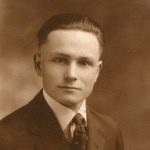
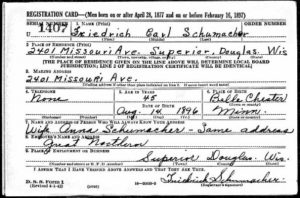 As I have researched my family history, I have come across a number of World War II draft registration cards for older men. I found that to be very strange. It seemed odd to me that men who were technically too old to serve in battle…at least by military standards, were required to register, and quite possibly be drafted into the war. Some of these men weren’t so very old by today’s standards, such as my great uncle, Friedrich Schumacher, who was 45 at the time of his World War II draft registration, or my grandfather, George Byer, who was 48 at the time of his World War II draft registration, but others, such as my grandfather, Allen Luther Spencer, who was 63 at the time of his World War II registration, were much older. These draft registrations really surprised me. Why would our government need to have these men register?
As I have researched my family history, I have come across a number of World War II draft registration cards for older men. I found that to be very strange. It seemed odd to me that men who were technically too old to serve in battle…at least by military standards, were required to register, and quite possibly be drafted into the war. Some of these men weren’t so very old by today’s standards, such as my great uncle, Friedrich Schumacher, who was 45 at the time of his World War II draft registration, or my grandfather, George Byer, who was 48 at the time of his World War II draft registration, but others, such as my grandfather, Allen Luther Spencer, who was 63 at the time of his World War II registration, were much older. These draft registrations really surprised me. Why would our government need to have these men register?
My curious mind had to know the answer to that question, and so I began to look online to see if anything was said about it at all. Well, it only took looking at three websites to find the answer. I wondered if they were just desperate for soldiers, because as most people know, World War II saw the most American war deaths at 405,399, than any other war in American history. Nevertheless, that was not the reason for the Fourth 
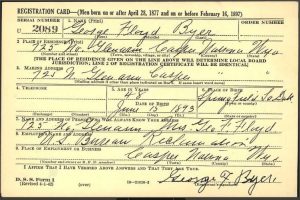 Registration, which became known as the Old Man’s Draft, because it targeted men between the ages of 45-64 years of age. No, these men were not going to be soldiers who were require to go into battle. This draft registration was intended to provide the government with a register of manpower…men who might be eligible for national service. Help was needed on the home front, and this was a way to ensure that the manpower needed was available. After all, if you are drafted, you are required to serve.
Registration, which became known as the Old Man’s Draft, because it targeted men between the ages of 45-64 years of age. No, these men were not going to be soldiers who were require to go into battle. This draft registration was intended to provide the government with a register of manpower…men who might be eligible for national service. Help was needed on the home front, and this was a way to ensure that the manpower needed was available. After all, if you are drafted, you are required to serve.
Registration of the Old Man’s Draft began on April 27, 1942 at local draft boards around the country, and like the patriotic citizens they were, my great uncle, and my grandfathers, along with many, many other older men, went to register. The lines were long when the men went in to register, according to the Poughkeepsie Journal, but the biggest regret that was heard among the men waiting there was…that they were too old to fight!! Seriously!! There were no complaints about standing for hours in line, or complaints about having to register at all…just that they would not see battle. These were not warmongers, but rather patriots who wanted to help in whatever way they could, and now Uncle Sam was telling them that their contribution was important. It felt 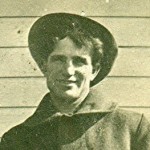
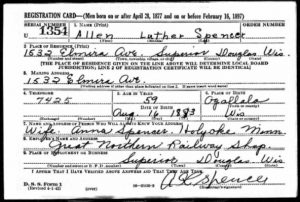 amazing to these men. They were needed!! The biggest complication was that some of the men couldn’t read or write, and some had forgotten things like addresses, telephone numbers, or dates (including the year of birth, which is evident on my grandfather’s card in that his year of birth was listed as 1883, but he was born in 1879). Nevertheless, these men were hopeful that somehow they could be useful in the war effort. I find that completely amazing…especially in light of the lack of patriotism so often seen these days.
amazing to these men. They were needed!! The biggest complication was that some of the men couldn’t read or write, and some had forgotten things like addresses, telephone numbers, or dates (including the year of birth, which is evident on my grandfather’s card in that his year of birth was listed as 1883, but he was born in 1879). Nevertheless, these men were hopeful that somehow they could be useful in the war effort. I find that completely amazing…especially in light of the lack of patriotism so often seen these days.
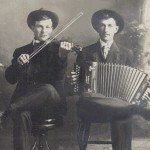 When my grandfather, Allen Spencer and my Great Uncle Albert Schumacher were young men, they were best friends. They did a lot together, including a trapping adventure, or should I say misadventure, which threatened to freeze them to death, causing them to decide that maybe the lumber business suited them better. I think maybe it did serve them better, but it wasn’t their occupations that really impressed me.
When my grandfather, Allen Spencer and my Great Uncle Albert Schumacher were young men, they were best friends. They did a lot together, including a trapping adventure, or should I say misadventure, which threatened to freeze them to death, causing them to decide that maybe the lumber business suited them better. I think maybe it did serve them better, but it wasn’t their occupations that really impressed me.
In his family history, my Uncle Bill Spencer, Allen’s oldest son, it was mentioned that Grandpa and Albert used to play the violin and the accordion at dances in the area. Then, Uncle Bill mentioned that he did to. I knew that music ran in the family, and while the ability to play an instrument passed me by, I do sing as a backup singer at my church. There are those in my family, however, who play quite well. My grandfather made sure that each of his children could play the violin, even though not all of them enjoyed it. I have to wonder if Grandpa wanted them to play because he loved it so much. I suppose that the excitement of playing in front of people and seeing them all having so much fun, was all Grandpa and Great Uncle Albert needed to be addicted…so to speak. Uncle Bill said that he played for dances too.
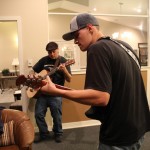
My girls, Corrie Petersen and Amy Royce, like many school children, played an instrument, but they continued on through high school. Neither one plays anymore, but I think the still could if they chose to. It’s one of those thing that you don’t forget, you just get a bit rusty. Still, if you continue to play, you could become quite good. My daughter, Amy’s husband, Travis and her son, Caalab both play the guitar. I don’t know how they feel about their ability to play, but I think they are both very good. They haven’t played at dances, but they have played at events where artists can go and play for others. I guess it doesn’t matter if you play at dances, for family, or for other events, being in the band is all that and more for a musician.
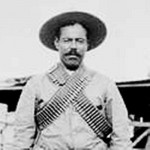 One day in mid 1916 or early 1917, my great uncle, John Spare, who would marry my great aunt, Mina Schumacher on January 8, 1921, was involved in an altercation along the Mexican border, while he was serving in Company B of the North Dakota National Guard. John had enlisted on June 30, 1916 at the age of just 17 years, and his company was assigned to the United States/Mexican border, as we were in the middle of a war with Mexico…really this was border patrol, because there were some pretty dangerous characters running around Mexico, terrorizing the people. One of the most notorious was Pancho Villa. The viciousness of José Doroteo Arango Arámbula…better known as Pancho Villa, was well documented. In a story told by a survivor of his first raid on March 7, 1916, the ruthlessness of this villain is made clear. Pancho Villa and 600 of his renegade followers rode into Columbus, Mexico (population 350) at four o’clock on that morning, riding horses and mules stolen from the Calvary at Camp Turlong just across the border. The camp was the headquarters for the 13th Calvary, and there were about 120 soldiers stationed there. Pancho and his men stole everything of value in the town, and set fire to all its buildings. Many merchants were killed, but the townspeople resisted so strongly that Pancho lost 100 men. He nevertheless, escaped to ride again and continue his raids on both sides of the border.
One day in mid 1916 or early 1917, my great uncle, John Spare, who would marry my great aunt, Mina Schumacher on January 8, 1921, was involved in an altercation along the Mexican border, while he was serving in Company B of the North Dakota National Guard. John had enlisted on June 30, 1916 at the age of just 17 years, and his company was assigned to the United States/Mexican border, as we were in the middle of a war with Mexico…really this was border patrol, because there were some pretty dangerous characters running around Mexico, terrorizing the people. One of the most notorious was Pancho Villa. The viciousness of José Doroteo Arango Arámbula…better known as Pancho Villa, was well documented. In a story told by a survivor of his first raid on March 7, 1916, the ruthlessness of this villain is made clear. Pancho Villa and 600 of his renegade followers rode into Columbus, Mexico (population 350) at four o’clock on that morning, riding horses and mules stolen from the Calvary at Camp Turlong just across the border. The camp was the headquarters for the 13th Calvary, and there were about 120 soldiers stationed there. Pancho and his men stole everything of value in the town, and set fire to all its buildings. Many merchants were killed, but the townspeople resisted so strongly that Pancho lost 100 men. He nevertheless, escaped to ride again and continue his raids on both sides of the border.
In haste, the United States sent soldiers to guard the borders. Unfortunately they were not well equipped, 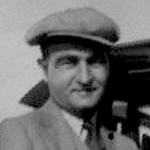 because of the unpreparedness of the military machine at the time. Many of those men, including my great uncle’s company were sent down there without ammunition, and told that those who had ammunition would fight an attack if it came, while the others would dive under the bridge until the attack was over. They neglected to tell them that none of them had ammunition, and the men did not know that until all of them jumped under the bridge at the same time. It was then that the horrible truth was revealed. The hope, apparently, was to make Pancho think this was a large army to be reckoned with, in the hope that they would not try to attack them. They sorely misjudged the ruthlessness of this man, but the good news was that Pancho and his men were already in a gun fight with the 13th Calvary, so they took little notice of this small band of men hiding under the bridge, hoping that the villain and his men didn’t circle around and come back. I don’t know how long Great Uncle John was stationed there, but it is my guess that one day was too much…unless they were given some ammunition, that is.
because of the unpreparedness of the military machine at the time. Many of those men, including my great uncle’s company were sent down there without ammunition, and told that those who had ammunition would fight an attack if it came, while the others would dive under the bridge until the attack was over. They neglected to tell them that none of them had ammunition, and the men did not know that until all of them jumped under the bridge at the same time. It was then that the horrible truth was revealed. The hope, apparently, was to make Pancho think this was a large army to be reckoned with, in the hope that they would not try to attack them. They sorely misjudged the ruthlessness of this man, but the good news was that Pancho and his men were already in a gun fight with the 13th Calvary, so they took little notice of this small band of men hiding under the bridge, hoping that the villain and his men didn’t circle around and come back. I don’t know how long Great Uncle John was stationed there, but it is my guess that one day was too much…unless they were given some ammunition, that is.
Great Uncle John survived the war, and returned to Fargo, North Dakota, where he married my Great Aunt Mina. While he would still serve in the military for a long time, their lives would be happy and blessed with a daughter, Pauline Jessie Spare, who always went by Paula, on March 23, 1922. Pancho Villa continued to wreak havoc in Mexico, and along the border, until 1920, when he retired. For whatever reason, he was given a large estate, which he turned into a Military Colony for his formers Villistas, as his men a become known. Then, in 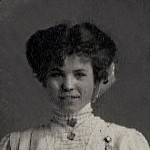 1923, Pancho decided to once again involve himself in Mexican politics, and on July 20, 1923, when he was killed by an assassin, who had probably been hired by the president of Mexico, Álvaro Obregón. When I read that Pancho Villa had been assassinated on this day in 1923, I remembered that Great Uncle John Spare had once had a close encounter with him, and I wondered how he and Great Aunt Min felt when they heard the news. Parral, Chihuahua, Mexico was a long way from Fargo, North Dakota, and a number of years had passed, so maybe they gave it little thought, or maybe they breathed a sigh of relief, knowing what kind of a man he was, and just how close Great Uncle John had come to losing his life that day, along the United States and Mexican Border.
1923, Pancho decided to once again involve himself in Mexican politics, and on July 20, 1923, when he was killed by an assassin, who had probably been hired by the president of Mexico, Álvaro Obregón. When I read that Pancho Villa had been assassinated on this day in 1923, I remembered that Great Uncle John Spare had once had a close encounter with him, and I wondered how he and Great Aunt Min felt when they heard the news. Parral, Chihuahua, Mexico was a long way from Fargo, North Dakota, and a number of years had passed, so maybe they gave it little thought, or maybe they breathed a sigh of relief, knowing what kind of a man he was, and just how close Great Uncle John had come to losing his life that day, along the United States and Mexican Border.

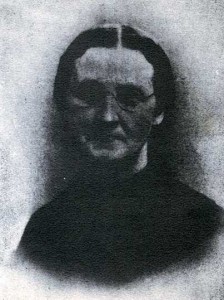 Years ago, I received a CD with a large amount of information on the Knox family, which is my husband, Bob Schulenberg’s mother, Joann Knox’s family. Knowing that these people…dozens of them…are related to you, and knowing how and where they fit in are two very different things. I have been trying to get them connected through Ancestry.com, for years, but really wasn’t able to successfully make the connections until I met John Knox, through his website and through Ancestry.com.
Years ago, I received a CD with a large amount of information on the Knox family, which is my husband, Bob Schulenberg’s mother, Joann Knox’s family. Knowing that these people…dozens of them…are related to you, and knowing how and where they fit in are two very different things. I have been trying to get them connected through Ancestry.com, for years, but really wasn’t able to successfully make the connections until I met John Knox, through his website and through Ancestry.com.
I suppose much of my problem was simply the time constraints, but when you are searching for a specific person without knowing how they fit into your family, but rather only that they do, the search can be endless. They might be the child or grandchild of your great uncle’s daughter. In order to find those connections, you need to go through every person’s children, their children, their 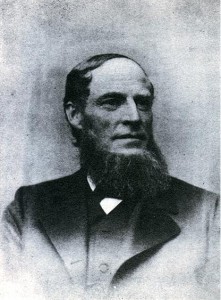
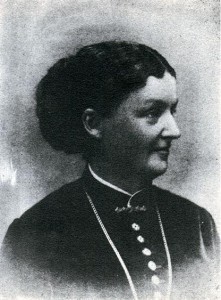 children, and so on. The process can be quite long. That is why making a connection, at any level, with a person who has done research on their family tree becomes one of the most exciting finds in your family history. By following their family back to where you suddenly stumble upon a familiar name from your own tree, you will find yourself face to face…sort of, with a common set of grandparents. Just like that, your family tree has one less mystery in it…or maybe now a new one.
children, and so on. The process can be quite long. That is why making a connection, at any level, with a person who has done research on their family tree becomes one of the most exciting finds in your family history. By following their family back to where you suddenly stumble upon a familiar name from your own tree, you will find yourself face to face…sort of, with a common set of grandparents. Just like that, your family tree has one less mystery in it…or maybe now a new one.
That was exactly how it was for me yesterday, when I finally connected the faces from the CD to the lines in my tree where they belonged. Names like Absolom Knox, who was born in 1738, married Mary Morrison, who was born in 1745, and they had a daughter named Sarah Knox. Sarah then married William Barr, and they had a son named Absolom Knox Barr. Absolom married Abia Foote Wormer, and they had a dughter named Sarah L Barr. Sarah married a man named James Beach…and that takes me in a totally new direction, and one in which they outcome is still unknown to me.

 My sister, Caryl Spencer’s first husband was Warren Beach, and together they have a daughter named Andrea and a son named Allen. Now, I know that my husband, Bob Schulenberg and I are tenth cousins on the Knox side of his family, and twelfth cousins on the Leary side of his family. So now the question becomes, is Warren Beach a cousin at some level. It would not be outside the realm of possibilities, you know. I’m sure it will take some time to trace things back to see if my hunch is right, but if it is, then not only would Caryl and Warren be cousins at some level, but Warren and Bob would be cousins at some level. As with many of my stories, this one will mst likely be the continuing saga…or maybe the mystery of the Knox/Beach connection.
My sister, Caryl Spencer’s first husband was Warren Beach, and together they have a daughter named Andrea and a son named Allen. Now, I know that my husband, Bob Schulenberg and I are tenth cousins on the Knox side of his family, and twelfth cousins on the Leary side of his family. So now the question becomes, is Warren Beach a cousin at some level. It would not be outside the realm of possibilities, you know. I’m sure it will take some time to trace things back to see if my hunch is right, but if it is, then not only would Caryl and Warren be cousins at some level, but Warren and Bob would be cousins at some level. As with many of my stories, this one will mst likely be the continuing saga…or maybe the mystery of the Knox/Beach connection.

